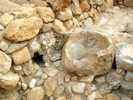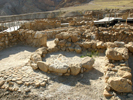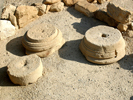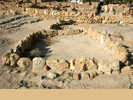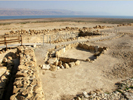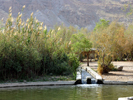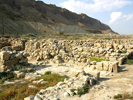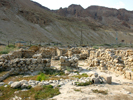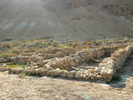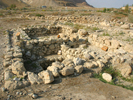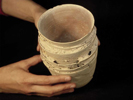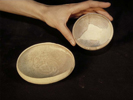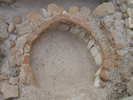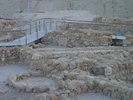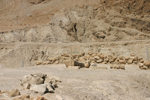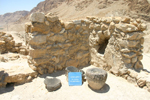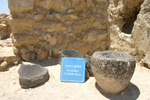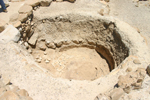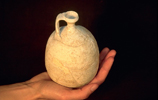Economic Life

Introduction
The economic life of the Dead Sea sect remains a matter of some controversy. The early scholarly emphasis upon the isolation of the Community, and the supposition of monastic asceticism, have given way to a new model of integration into the thriving economic life of the Dead Sea region. Although the soil in the Dead Sea area is dry, salty and non-cultivatable, arable lands are found near Qumran at Ein-Feshkha and in the Buqeia valley. It is considered likely that the mainstay of the economy of the Qumran Community was agriculture and sheep/goat herding in these neighboring oases. In particular, there is evidence of the cultivation of dates, which are likely to have been processed into honey in the date-presses found at Qumran. It has been suggested that the sectarians harvested grain, legumes and grapes. Evidence of the sect’s agricultural activities may be found in the Community Rule, which notes that the summer season is for harvesting, and the season of grass, the spring, is the time for sowing. Additional occupations at the site included scribal activity and pottery-making. It is a point of debate, whether these occupations represented commercial enterprises or whether they were intended solely to meet the community’s needs.
Property:
Probably the most noteworthy aspect of the Qumran economy is the sect’s communal ownership of property, as found in the Rule of the Community (1QS 1:12-13; 6:20, 23). New members were required to deposit their property with the communal treasury, from which the sect’s expenses were paid. Members were responsible for handing over profits to the treasury and for reimbursing community property lost through business dealings (see 1QS 6:2, 7:7). An ostracon discovered at Qumran in 1996 may offer corroborating evidence for the textual descriptions of the pooling of property. According to its editors, this so-called “Yahad ostracon” constitutes a deed of a gift, or perhaps a draft of a deed, in which a person named Honi transfers his estate and a slave to an individual named Eleazar. The editors suggest—based on the reference to “fulfilling [an oath to the community (yahad)]” —that the ostracon describes a member handing over his property in one of the advanced stages of joining the community. They identify Eleazar as a community official such as the Mevaqqer or the Paqid (See Qumran Community Leaders).
With regard to commercial relations, the Damascus Document indicates that members should not buy from or sell to each other (except “hand to hand” CD 13:15). Michael Knibb explains that people provided for their needs by a barter-like exchange system. If one wanted to participate in a profit-making transaction, he would have had to get the transaction approved by the Paqid.
Communal ownership is one aspect of a larger agenda in the scrolls, of opposition to greed and excessive wealth. Archaeological evidence supports the supposition that the sectarians led a simple lifestyle, but this need not be taken as evidence of a low standard of living. Contrary indications include the following:
1. A large number of coins were found at Qumran from several surrounding areas, attesting to a significant level of commercial relations.
2. More water was accumulated at the site than was needed by the people for basic living.
3. The aqueduct that brought the water to the site appears to have been created and operated by Roman devices.
4. A plethora of animal bones were found near the dining hall, intimating that the sectarians ate meat. Meat was an expensive commodity in Judaea at that time.
5. Decorated column capitals were found at the site ( see Hirshfeld)
6. Some fine glassware was found at the site.
More Info
- Magen Broshi, “Date Beer and Date Wine in Antiquity,” Palestine Exploration Quarterly 139, 1 (2007) 55-59.
- Cross, Frank Moore and E. Eshel. “Ostraca from Khirbet Qumran.” Israel Exploration Journal 47 (1997): 17–28.
- Flusser, David. “Qumran and the Famine during the Reign of Herod.” Israel Museum Journal 6 (1987) 7-16
- Har-El, Menashe. “Agriculture.” Pages 13-16 in Encyclopedia of the Dead Sea Scrolls Volume I. Edited by Lawrence H. Schiffman and James C. Vanderkam. Oxford: Oxford University Press, 2000.
- Hempel, Charlotte. “Community Structures in the Dead Sea Scrolls: Admission, Organization, Disciplinary Procedures.” Pages 67-92 in The Dead Sea Scrolls After Fifty Years: a comprehensive assessment, Vol. II. Edited by Peter W. Flint and James C. Vanderkam. Leiden, The Netherlands: Brill, 1999.
- Knibb, Michael. “Community Organization in the Damascus Document.” Pages 135–138 in vol.1 of Encyclopedia of the Dead Sea Scrolls, ed. Lawrence H. Schiffman and James C. VanderKam. 2 vols. New York: Oxford University Press, 2000.
- Safrai, Ze’ev and Hanan Eshel. “Economic Life.” Pages 228-233 in Encyclopedia of the Dead Sea Scrolls Volume I. Edited by Lawrence H. Schiffman and James C. Vanderkam. Oxford: Oxford University Press, 2000.
- Yardeni, Ada. “A Draft of a Deed: On an Ostracon from Khirbet Qumran,” Israel Exploration Journal 47 (1997), pp. 233-237.
